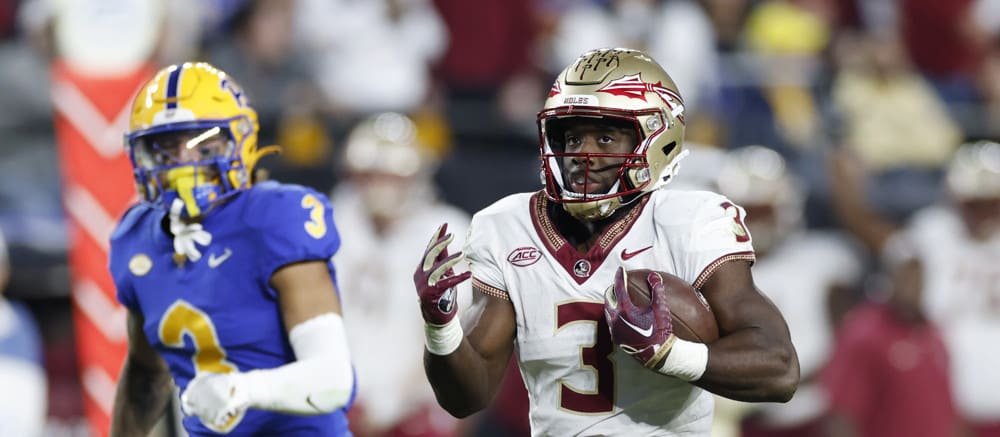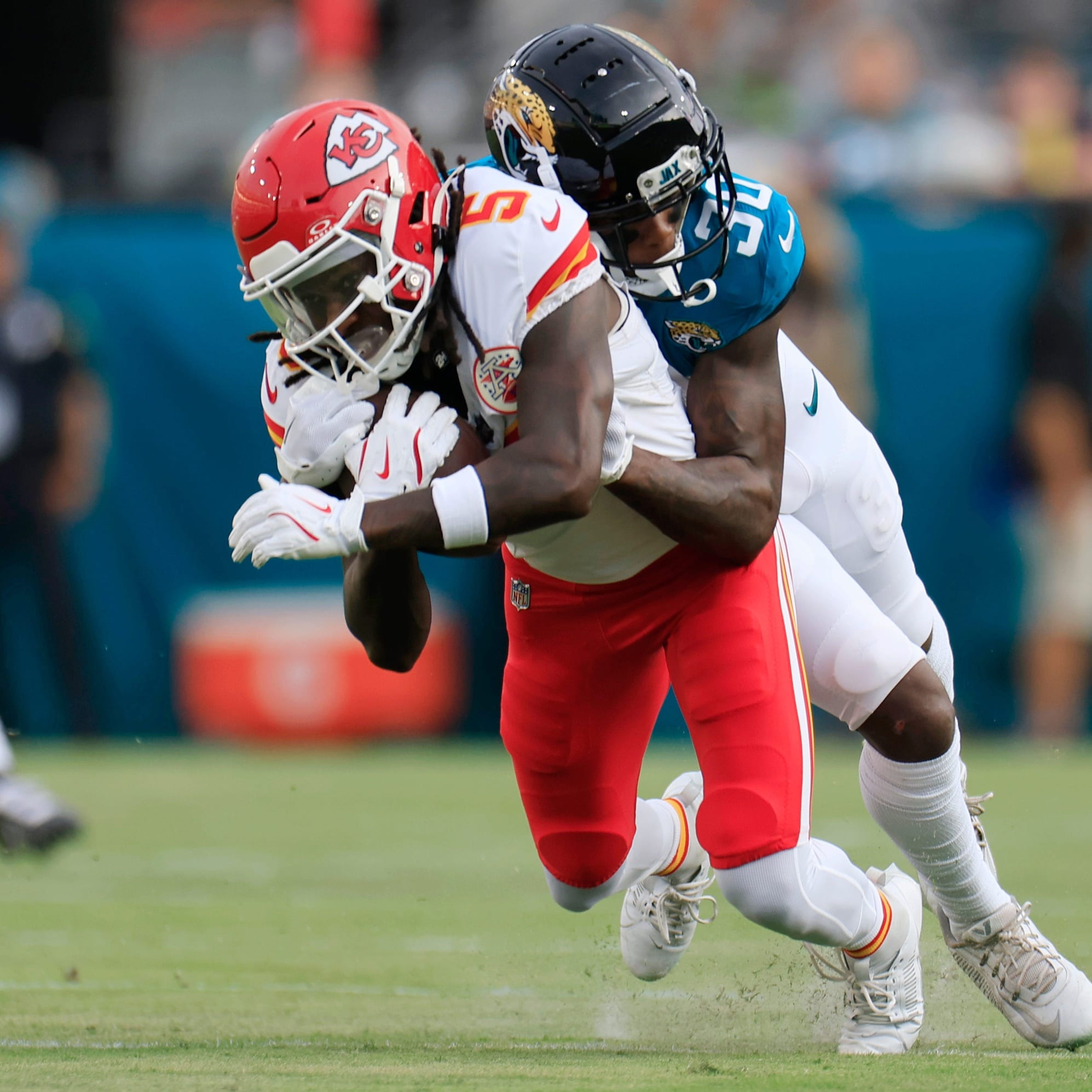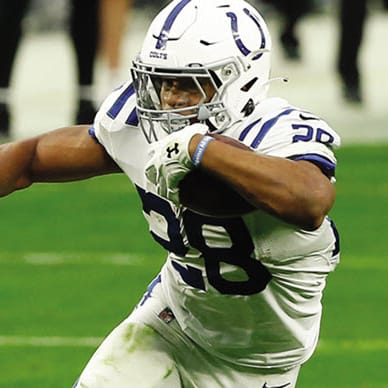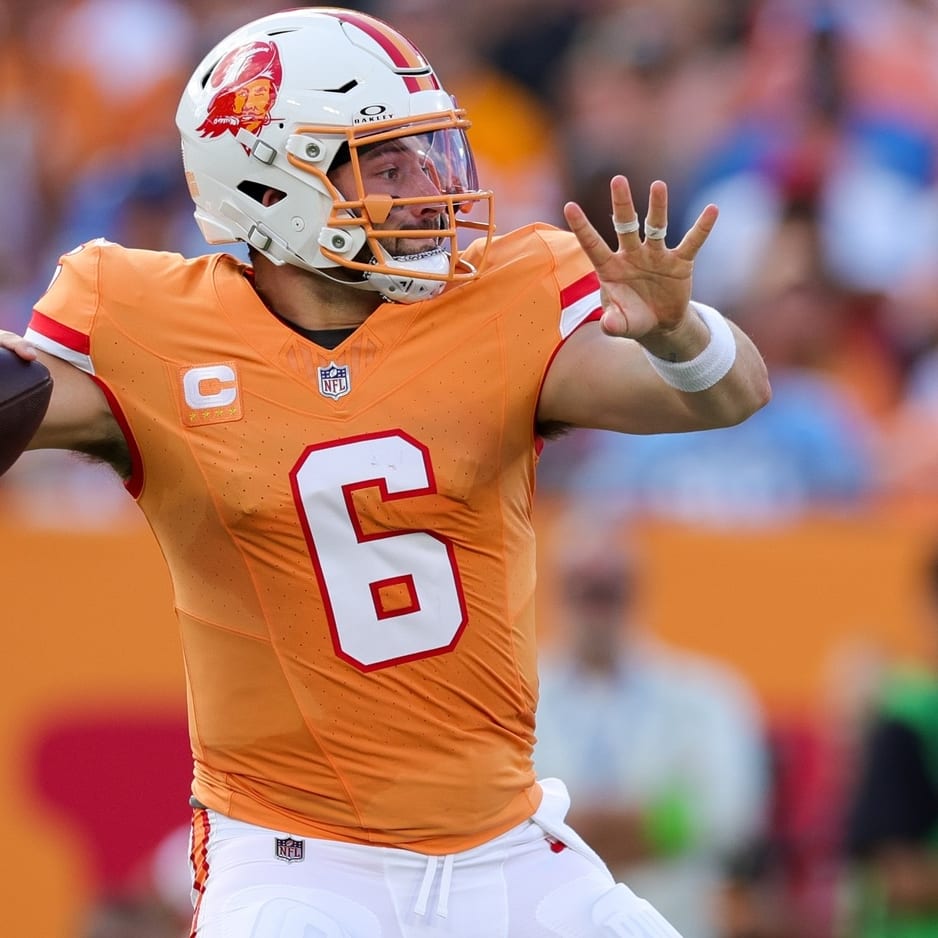This article is part of our Dynasty Strategy series.
This article series intends to cut through the noise of the broader prospect analysis that generally circulates through fantasy football internet media, specifically at the running back position.
More than any other, running back is one position where the evaluation is simple. Production and athletic testing win out, reliably. By focusing on production and standout athleticism you can quickly discern the general functions of a running back and the general effect they bring to the field.
This series will look only at the 2024 rookie running backs, highlighting the pertinent details in their prospect profiles and offering comparisons for how their NFL careers might unfold based on how things turned out for similar players in the past. This post will look at Jonathon Brooks and Trey Benson. The next will look at least at Blake Corum and MarShawn Lloyd.
A general verdict and player comparison is at the bottom of each blurb.
Jonathan Brooks, CAR (Round 2, 46th overall)
Brooks (6-foot, 216 pounds) looks like at least an average starting NFL running back prospect, but probably no more than a slightly above-average one. Brooks was unable to participate in athletic testing due to an ACL tear from Nov. 11. He missed time with injury in at least two of his three seasons at Texas – the ACL in 2023, and a shoulder injury in 2021. Brooks only played in seven 2022 games, for some reason.
[Skill set]
Brooks' production was explosive at Texas, but the quality of
This article series intends to cut through the noise of the broader prospect analysis that generally circulates through fantasy football internet media, specifically at the running back position.
More than any other, running back is one position where the evaluation is simple. Production and athletic testing win out, reliably. By focusing on production and standout athleticism you can quickly discern the general functions of a running back and the general effect they bring to the field.
This series will look only at the 2024 rookie running backs, highlighting the pertinent details in their prospect profiles and offering comparisons for how their NFL careers might unfold based on how things turned out for similar players in the past. This post will look at Jonathon Brooks and Trey Benson. The next will look at least at Blake Corum and MarShawn Lloyd.
A general verdict and player comparison is at the bottom of each blurb.
Jonathan Brooks, CAR (Round 2, 46th overall)
Brooks (6-foot, 216 pounds) looks like at least an average starting NFL running back prospect, but probably no more than a slightly above-average one. Brooks was unable to participate in athletic testing due to an ACL tear from Nov. 11. He missed time with injury in at least two of his three seasons at Texas – the ACL in 2023, and a shoulder injury in 2021. Brooks only played in seven 2022 games, for some reason.
[Skill set]
Brooks' production was explosive at Texas, but the quality of that production is dubious. As much as it's great that Brooks averaged 6.2 yards per carry with a 6.7 percent touchdown rate, it's less impressive when you frame it in terms of quality starts.
Brooks logged 24.3 percent of his rushing yardage against Kansas alone. Against non-Kansas opponents Brooks' rushing average drops to 5.6 yards per carry, which is the same as Roschon Johnson's career average at Texas. Brooks is definitely a better pure runner and a much better overall prospect than Johnson, but there's still a clear magnitude or two between the production quality of Brooks versus, say, Bijan Robinson.
While Brooks' collegiate rushing production doesn't obviously indicate a starting-scale NFL rusher, his pass-catching production is more clearly positive. Even if you subtract the 73-yard catch against TCU, Brooks finished his Texas career turning 32 targets into 27 receptions for 262 yards, which would still be good for an exceptional 84.4 percent catch rate at 8.2 yards per target. If Brooks is to emerge as a standout fantasy running back it will likely be largely or primarily due to his standout pass-catching ability. If Brooks is productive enough as a pass catcher then it could offset any limitations in his usage volume or rushing efficiency.
[Tool set]
It's difficult to guess Brooks' athleticism grade because he was unable to do any pre-draft athletic testing. There are clues in his tape, however.
Brooks was listed at 207 pounds during his final year at Texas, and during that season he got into several foot chases with defenders who logged 40-yard dash times. Two such players are TCU defensive backs Mark Perry and Josh Newton. Brooks nearly scored on a screen pass from the Texas 25, and on that play Perry gained on Brooks while Newton mostly held stride. Newton logged a 4.52-second 40 at the combine, while at the TCU pro day Perry was credited with a 4.42-second 40.
Based on the outcome of that play and the athletic testing of Perry/Newton, I think it's reasonable to suggest that Brooks likely runs a 40-yard dash in the range of 4.48 to 4.55 seconds at 207 pounds. If Brooks weighed around 207 pounds on that play then I think at Brooks' 216 combine weight he would more likely run in the 4.55-to-4.58 range.
A 4.58-second 40 is fine for a 216-pound running back, but it would also present a trait profile that lacks big plays and therefore requires standout volume to produce standout fantasy point totals. Based on Brooks' injury history at Texas, it might be best if he's used less like a grinder between the tackles and more like a threat in space. Brooks sees the field well and has a good sense of pacing, so giving him space to work with is an easy way to keep him consistently effective.
It still would be nice if Brooks were to prove faster than the 40 times speculated here. At over 6-feet tall Brooks doesn't have a great deal of natural anchor, and though he has the flexibility and good sense to break down in traffic his initial lean is more upright than it is low. Staying away from the most hostile parts of the defense is a generally good idea, and maybe the best way to capitalize on his open-field vision.
Chuba Hubbard did well in 2023 and might earn some substantial workload in 2024, but Brooks' full arrival should be no later than Week 1 of 2025. The Panthers will need to run the ball well and often in 2024, so there might be plenty of work for both of Hubbard and Brooks while the rookie works his way back from the ACL injury. Brooks will likely be particularly imposing as a pass catcher, so it would make sense if the Panthers made his initial tasks along those lines rather than much in the way of power running.
BEST-CASE COMPARISON: LeSean McCoy. McCoy's production at Pittsburgh was several magnitudes better than Brooks' at Texas, but McCoy was a dominant NFL runner even without standout athletic testing. If there's a case study of a running back providing high-volume, high-efficiency returns without plus tools then McCoy is the primary example in recent times.
LIKELY COMPARISON: Rachaad White. Like Brooks, White is a bit more upright than he is anchored and as a pure runner White is no better than average. But also like Brooks, White is a plus pass catcher capable of catching 60-plus receptions at above-average efficiency.
Trey Benson, ARI (Round 3, 66th overall)
Benson (6-feet, 216 pounds) looks a little heavier in his game tape, so it wouldn't be surprising if he shed some pounds to boost his 40 time (4.39 seconds) at the combine. Indeed, Benson was listed at 223 pounds by Florida State. Be it at 223 or 216, Benson is fast – uncommonly fast for a running back of his build. In terms of size and speed Benson has traits that conventionally project for a three-down workload, but his upright lean and history of one nasty knee injury at Oregon leave the scalability of Benson's usage in some amount of question. What seems safe to take as a given in the meantime is that Benson will prove uncommonly explosive with the football.
[Skill set]
Benson is a homerun hitter at running back. He finished his Florida State career with 1,896 yards and 23 touchdowns on just 310 carries -- good for 6.1 yards per carry with a 7.4 percent touchdown rate. Although he never showed an ability to take on big volume, Benson's frame allows him to run with power in addition to his long-range speed. Any defender tasked with a 1-on-1 tackle will do so with fear, because Benson can shake the tackle equally well by power or elusiveness. If Benson shakes that defender then the others are unlikely to catch him.
Benson is probably not as good of a receiver as Brooks, but Benson too could establish himself as an above-average receiver at the NFL level. In his two Florida State seasons Benson turned 44 targets into 33 receptions for 371 yards (75.0 percent catch rate, 8.4 yards per target), and he looked natural enough doing so that it seems safe to project Benson for 50-reception upside in the NFL, and maybe even more if his snap count can rise past 600 or so.
[Tool set]
Benson's 4.39-second 40 at 216 pounds is an excellent number. Even if Benson adds weight and plays at something closer to 225 pounds he'd likely run something like a 4.42-4.45 40 at worst, and either time will work for long-range speed. It's possible that Benson's otherwise standout mass won't translate into usage volume, but even if a lack of durability preempts Benson's chances of a workhorse role the power element will remain in play on any given touch.
It's not common to see a big power back who also has workload limitations, but Benson never took on a big workload at Florida State (just one career 20-carry game) and it's possible that they limited his usage for some tangible reason or another. As much as Benson's knee injury at Oregon doesn't doom him to a career of injury troubles, it's also not the sort of injury you want in a prospect's history.
James Conner is probably one of the better running backs league-wide, but he has a reliable history of missing games due to various injuries. Conner dishes out more punishment than he takes, but by grinding through the teeth of the defense Conner still takes a lot of punishment. Benson should prove an explosive change-of-pace player whenever Conner is healthy, and if Conner is out the Cardinals could quickly become dependent on Benson's explosiveness.
BEST-CASE COMPARISON: DeMarco Murray. If Benson can bulk back up a bit and prove that his injury issues are behind him then there would be no obvious remaining reason why Benson's production couldn't scale up to a workhorse workload. Murray bulked up in the NFL and traded off some of his speed for power and longevity, and Benson might be able to do the same thing.
LIKELY COMPARISON: Raheem Mostert. If Benson can't turn his otherwise standout mass into workload longevity then in terms of usage and returns he might look like peak Mostert. Mostert lacks the power and mass that Benson runs with, but Mostert's workload limitations could be a similar theme in Benson's profile if Benson's NFL usage looks like his collegiate usage.









